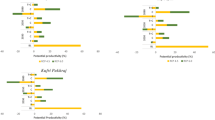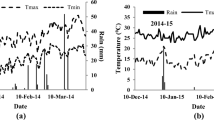Abstract
This study aims to assess the risks and opportunities posed by climate change to potato growers in South Africa and to evaluate adaptation measures in the form of changes in planting time growers could adopt to optimise land and water use efficiencies in potato, using a climate model of past, present-day and future climate over southern Africa and the LINTUL crop growth model. This was done for distinct agro-ecosystems in South Africa: the southern Mediterranean area where potato still is grown year round with a doubling of the number of hot days between 1960 and 2050, the Eastern Free State with summer crops only and Limpopo with currently autumn, winter and spring crops where the number of hot days increases sevenfold and in future the crop will mainly be grown in winter. A benefit here will be a drastic reduction of frost days from 0.9 days per winter to 0. Potato crops in the agro-ecosystems will benefit considerably from increased CO2 levels such as increased tuber yield and reduced water use by the crop, if planting is shifted to appropriate times of the year. When the crop is grown in hot periods, however, these benefits are counteracted by an increased incidence of heat stress and increased evapotranspiration, leading in some instances to considerably lower yields and water use efficiencies. Therefore year-round total production at the Sandveld stabilizes at around 140 Mg ha−1 (yield reduction in summer and yield increase in winter), increases by about 30% in the Free State and stays at about 95 t ha−1 at Limpopo where yield increase due to CO2 is annulled by a shorter growing season. When the crop is grown in a cool period, there is an additional benefit of a reduced incidence of cold stress and a more rapid canopy development in the early stages of crop growth. In all three areas, potato growers are likely to respond to climate change by advancing planting. In Limpopo, a major benefit of climate change is a reduction in the risk of frost damage in winter. The relevance of these findings for potato grown in agro-ecosystems elsewhere in the world is discussed.





Similar content being viewed by others
References
Allen RG, Smith M, Pruitt WO, Pereira LS (1996) Modifications to the FAO crop coefficient approach. Proc Int Conf Evapotranspiration Irrigation Scheduling, San Antonio, Texas, USA, pp. 124–132
Archer ERM, Conrad J, Munch Z, Opperman D, Tadross MA, Venter J (2009) Climate change and commercial agribusiness in the semi-arid northern Sandveld, South Africa. J Integr Env Sci 6:139–155
Engelbrecht FA, McGregor JL, Engelbrecht CJ (2009) Dynamics of the conformal cubic atmospheric model projected climate-change signal over southern Africa. Int J Climatol 29:1013–1033
Engelbrecht CJ, Engelbrecht FA, Dyson LL (2013) High-resolution model-projected changes in mid-tropospheric closed-lows and extreme rainfall events over southern Africa. Int J Climatol 33:173–187
Franke AC, Steyn JM, Ranger KS, Haverkort AJ (2011) Developing environmental principles, criteria, indicators and norms for potato production through field surveys and modelling. Agric Syst 104:297–306
Haverkort AJ, Harris PM (1987) A model for potato growth and yield under tropical highland conditions. Agric Forest Meteorol 39:271–282
Haverkort AJ, Verhagen A (2008) Climate change and the repercussions for the potato supply chain. Potato Res 51:223–237
Haverkort AJ, Franke AC, Engelbrecht FA, Steyn JM (2013) Climate change and potato production in contrasting South African agro-ecosystems 1. Effects of land and water use efficiencies. doi:10.1007/s11540-013-9230-4
IPCC (2001) Climate change 2001. Impacts, adaptation and vulnerability. Cambridge University Press, Cambridge
Jaggard KW, Qi A, Ober AA (2010) Possible changes to crop yield by 2050. Philos T Roy Soc Bot 365:2835–2851
Kooman PL, Haverkort AJ (1994) Modelling development and growth of the potato crop influenced by temperature and daylength: LINTUL-POTATO. In: Haverkort AJ, MacKerron DKL (eds) Ecology and modeling of potato crops under conditions limiting growth. Kluwer Academic Publishers, Dordrecht, pp 41–60
Potatoes South Africa (2011) SA potato industry—hectares and crop size. http://www.potatoes.co.za/industry-information/national-annual-information.aspx (accessed Jan 2013)
Reidsma P, Ewert F, Oude Lansink A, Leemans R (2010) Adaptation to climate change and climate variability in European agriculture: the importance of farm level responses. Eur J Agron 32:91–102
Schapendonk AHCM, van Oijen M, Dijkstra M, Pot SC, Jordi WJRM, Stoopen GM (2000) Effects of CO2 concentration on photosynthetic acclimation and productivity of two potato cultivars grown in open-top chambers. Austr J Plant Physiol 27:1119–1130
Smit B, Skinner MW (2002) Adaptation options in agriculture to climate change: a typology. Mitig Adapt Strateg Glob Chang 7:85–114
Smith M, Allen RG, Pereira LS (1996) Revised FAO methodology for crop water requirements. Proc Int Conf Evapotranspiration and Irrigation Scheduling, San Antonio, Texas, USA, pp 133–140
Spitters CJT (1990) Crop growth models: their usefulness and limitations. Acta Hort 267:349–368
Van der Waals JE, Franke AC, Haverkort AJ, Krüger K, Steyn JM (2013) Climate change and potato production in contrasting South African agro-ecosystems 3. Effects on relative development rates of selected pathogens and pests. Potato Res 56:xxx–xxx
Acknowledgments
We thank Potatoes South Africa and the Netherlands Ministry of Economy, Agriculture and Innovation Agriculture, especially prof. Nico Visser, Agricultural Counsellor at the Netherlands Embassy in Pretoria, for financial support.
Author information
Authors and Affiliations
Corresponding author
Rights and permissions
About this article
Cite this article
Franke, A.C., Haverkort, A.J. & Steyn, J.M. Climate Change and Potato Production in Contrasting South African Agro-Ecosystems 2. Assessing Risks and Opportunities of Adaptation Strategies. Potato Res. 56, 51–66 (2013). https://doi.org/10.1007/s11540-013-9229-x
Received:
Accepted:
Published:
Issue Date:
DOI: https://doi.org/10.1007/s11540-013-9229-x




